microsoft AI-900 Exam Questions
Questions for the AI-900 were updated on : Jun 25 ,2025
Page 1 out of 9. Viewing questions 1-15 out of 130
Question 1 Topic 1, Describe Artificial Intelligence workloads and considerations
A company employs a team of customer service agents to provide telephone and email support to customers.
The company develops a webchat bot to provide automated answers to common customer queries.
Which business benefit should the company expect as a result of creating the webchat bot solution?
- A. increased sales
- B. a reduced workload for the customer service agents
- C. improved product reliability
Answer:
B
Question 2 Topic 1, Describe Artificial Intelligence workloads and considerations
For a machine learning progress, how should you split data for training and evaluation?
- A. Use features for training and labels for evaluation.
- B. Randomly split the data into rows for training and rows for evaluation.
- C. Use labels for training and features for evaluation.
- D. Randomly split the data into columns for training and columns for evaluation.
Answer:
B
Explanation:
The Split Data module is particularly useful when you need to separate data into training and testing sets. Use the Split
Rows option if you want to divide the data into two parts. You can specify the percentage of data to put in each split, but by
default, the data is divided 50-50. You can also randomize the selection of rows in each group, and use stratified sampling.
Reference: https://docs.microsoft.com/en-us/azure/machine-learning/studio-module-reference/split-data
Question 3 Topic 1, Describe Artificial Intelligence workloads and considerations
HOTSPOT
You are developing a model to predict events by using classification.
You have a confusion matrix for the model scored on test data as shown in the following exhibit.
Use the drop-down menus to select the answer choice that completes each statement based on the information presented in
the graphic.
NOTE: Each correct selection is worth one point.
Hot Area: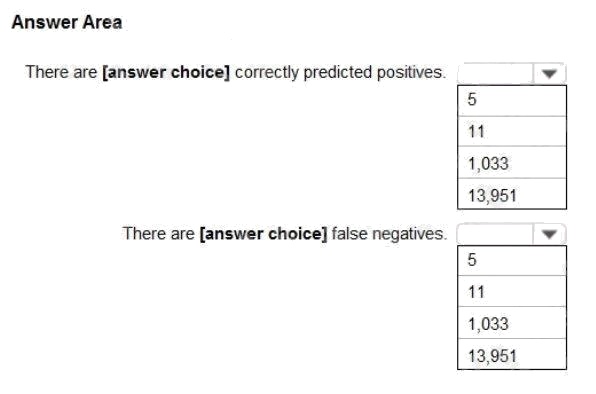
Answer:
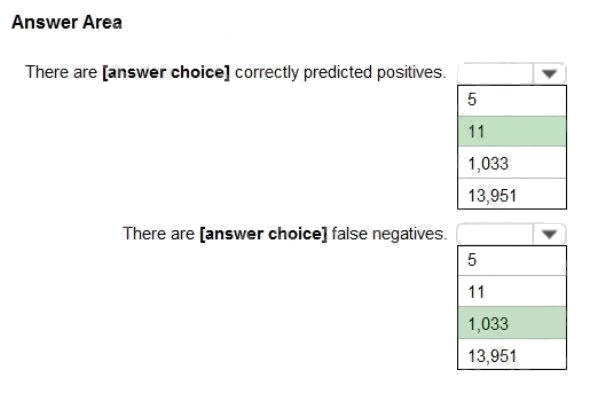
Explanation:
Box 1: 11
TP = True Positive.
The class labels in the training set can take on only two possible values, which we usually refer to as positive or negative.
The positive and negative instances that a classifier predicts correctly are called true positives (TP) and true negatives (TN),
respectively. Similarly, the incorrectly classified instances are called false positives (FP) and false negatives (FN).
Box 2: 1,033
FN = False Negative
Reference: https://docs.microsoft.com/en-us/azure/machine-learning/studio/evaluate-model-performance
Question 4 Topic 1, Describe Artificial Intelligence workloads and considerations
You build a machine learning model by using the automated machine learning user interface (UI).
You need to ensure that the model meets the Microsoft transparency principle for responsible AI.
What should you do?
- A. Set Validation type to Auto.
- B. Enable Explain best model.
- C. Set Primary metric to accuracy.
- D. Set Max concurrent iterations to 0.
Answer:
B
Explanation:
Model Explain Ability.
Most businesses run on trust and being able to open the ML black box helps build transparency and trust. In heavily
regulated industries like healthcare and banking, it is critical to comply with regulations and best practices. One key aspect of
this is understanding the relationship between input variables (features) and model output. Knowing both the magnitude and
direction of the impact each feature (feature importance) has on the predicted value helps better understand and explain the
model. With model explain ability, we enable you to understand feature importance as part of automated ML runs.
Reference: https://azure.microsoft.com/en-us/blog/new-automated-machine-learning-capabilities-in-azure-machine-learning-
service/
Question 5 Topic 1, Describe Artificial Intelligence workloads and considerations
HOTSPOT
For each of the following statements, select Yes if the statement is true. Otherwise, select No.
NOTE: Each correct selection is worth one point.
Hot Area: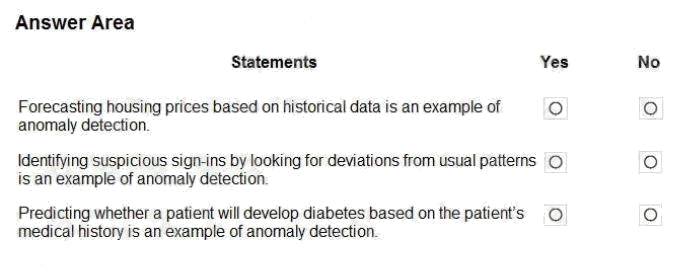
Answer:
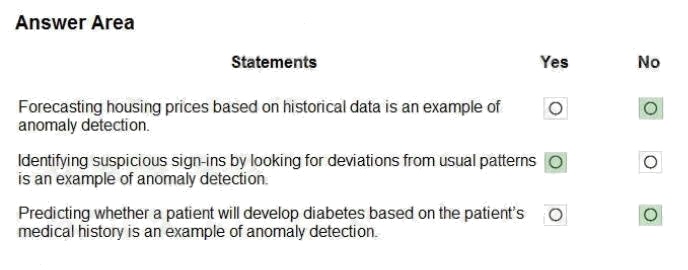
Explanation:
Anomaly detection encompasses many important tasks in machine learning:
Identifying transactions that are potentially fraudulent.
Learning patterns that indicate that a network intrusion has occurred.
Finding abnormal clusters of patients.
Checking values entered into a system.
Reference: https://docs.microsoft.com/en-us/azure/machine-learning/studio-module-reference/anomalydetection
Question 6 Topic 1, Describe Artificial Intelligence workloads and considerations
HOTSPOT
To complete the sentence, select the appropriate option in the answer area.
Hot Area: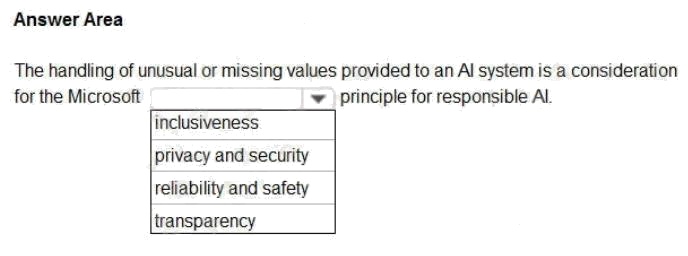
Answer:
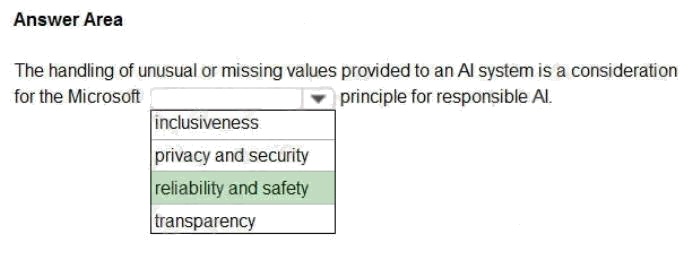
Explanation:
Reliability and safety:
AI systems need to be reliable and safe in order to be trusted. It is important for a system to perform as it was originally
designed and for it to respond safely to new situations. Its inherent resilience should resist intended or unintended
manipulation. Rigorous testing and validation should be established for operating conditions to ensure that the system
responds safely to edge cases, and A/B testing and champion/challenger methods should be integrated into the evaluation
process.
An AI system's performance can degrade over time, so a robust monitoring and model tracking process needs to be
established to reactively and proactively measure the model's performance and retrain it, as necessary, to modernize it.
Reference: https://docs.microsoft.com/en-us/azure/cloud-adoption-framework/innovate/best-practices/trustedai
Question 7 Topic 1, Describe Artificial Intelligence workloads and considerations
DRAG DROP
Match the types of AI workloads to the appropriate scenarios.
To answer, drag the appropriate workload type from the column on the left to its scenario on the right. Each workload type
may be used once, more than once, or not at all.
NOTE: Each correct selection is worth one point.
Select and Place: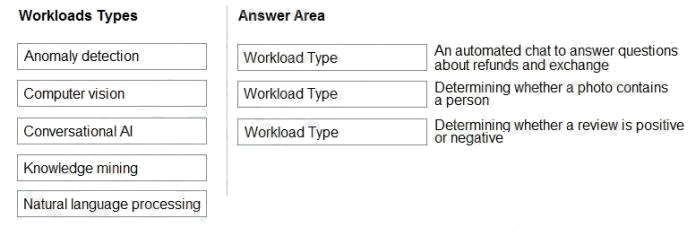
Answer:
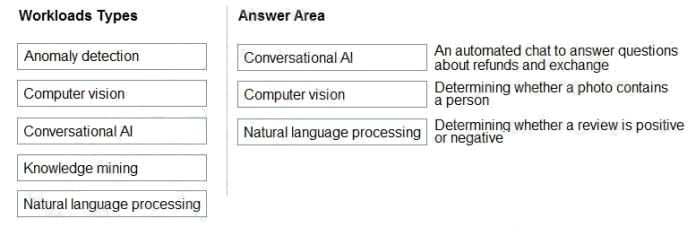
Explanation:
Box 3: Natural language processing
Natural language processing (NLP) is used for tasks such as sentiment analysis, topic detection, language detection, key
phrase extraction, and document categorization.
Reference: https://docs.microsoft.com/en-us/azure/architecture/data-guide/technology-choices/natural-language-processing
Question 8 Topic 1, Describe Artificial Intelligence workloads and considerations
You are designing an AI system that empowers everyone, including people who have hearing, visual, and other impairments.
This is an example of which Microsoft guiding principle for responsible AI?
- A. fairness
- B. inclusiveness
- C. reliability and safety
- D. accountability
Answer:
B
Explanation:
Inclusiveness: At Microsoft, we firmly believe everyone should benefit from intelligent technology, meaning it must
incorporate and address a broad range of human needs and experiences. For the 1 billion people with disabilities around the
world, AI technologies can be a game-changer.
Reference: https://docs.microsoft.com/en-us/learn/modules/responsible-ai-principles/4-guiding-principles
Question 9 Topic 1, Describe Artificial Intelligence workloads and considerations
DRAG DROP
Match the Microsoft guiding principles for responsible AI to the appropriate descriptions.
To answer, drag the appropriate principle from the column on the left to its description on the right. Each principle may be
used once, more than once, or not at all.
NOTE: Each correct selection is worth one point.
Select and Place: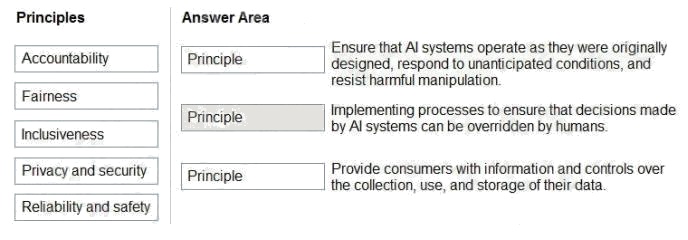
Answer:
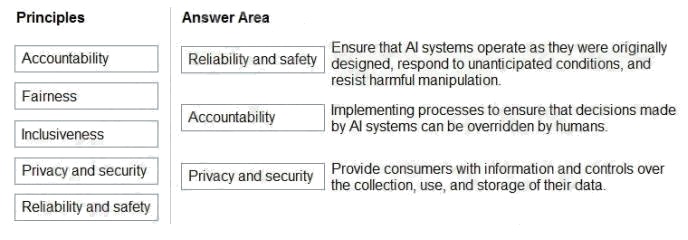
Explanation:
Box 1: Reliability and safety
To build trust, it's critical that AI systems operate reliably, safely, and consistently under normal circumstances and in
unexpected conditions. These systems should be able to operate as they were originally designed, respond safely to
unanticipated conditions, and resist harmful manipulation.
Box 2: Accountability
The people who design and deploy AI systems must be accountable for how their systems operate. Organizations should
draw upon industry standards to develop accountability norms. These norms can ensure that AI systems are not the final
authority on any decision that impacts people's lives and that humans maintain meaningful control over otherwise highly
autonomous AI systems.
Box 3: Privacy and security
As AI becomes more prevalent, protecting privacy and securing important personal and business information is becoming
more critical and complex. With AI, privacy and data security issues require especially close attention because access to
data is essential for AI systems to make accurate and informed predictions and decisions about people. AI systems must
comply with privacy laws that require transparency about the collection, use, and storage of data and mandate that
consumers have appropriate controls to choose how their data is used
Reference:
https://docs.microsoft.com/en-us/learn/modules/responsible-ai-principles/4-guiding-principles
Question 10 Topic 1, Describe Artificial Intelligence workloads and considerations
HOTSPOT
To complete the sentence, select the appropriate option in the answer area.
Hot Area:
Answer:

Explanation:
Reliability and safety: To build trust, it's critical that AI systems operate reliably, safely, and consistently under normal
circumstances and in unexpected conditions. These systems should be able to operate as they were originally designed,
respond safely to unanticipated conditions, and resist harmful manipulation.
Reference:
https://docs.microsoft.com/en-us/learn/modules/responsible-ai-principles/4-guiding-principles
Question 11 Topic 1, Describe Artificial Intelligence workloads and considerations
You are building an AI system.
Which task should you include to ensure that the service meets the Microsoft transparency principle for responsible AI?
- A. Ensure that all visuals have an associated text that can be read by a screen reader.
- B. Enable autoscaling to ensure that a service scales based on demand.
- C. Provide documentation to help developers debug code.
- D. Ensure that a training dataset is representative of the population.
Answer:
C
Explanation:
Reference:
https://docs.microsoft.com/en-us/learn/modules/responsible-ai-principles/4-guiding-principles
Question 12 Topic 1, Describe Artificial Intelligence workloads and considerations
DRAG DROP
Match the types of AI workloads to the appropriate scenarios.
To answer, drag the appropriate workload type from the column on the left to its scenario on the right. Each workload type
may be used once, more than once, or not at all.
NOTE: Each correct selection is worth one point.
Select and Place:
Answer:

Explanation:
Reference:
https://docs.microsoft.com/en-us/learn/paths/get-started-with-artificial-intelligence-on-azure/
Question 13 Topic 1, Describe Artificial Intelligence workloads and considerations
Your company is exploring the use of voice recognition technologies in its smart home devices. The company wants to
identify any barriers that might unintentionally leave out specific user groups.
This an example of which Microsoft guiding principle for responsible AI?
- A. accountability
- B. fairness
- C. inclusiveness
- D. privacy and security
Answer:
C
Explanation:
Reference: https://docs.microsoft.com/en-us/learn/modules/responsible-ai-principles/4-guiding-principles
Question 14 Topic 1, Describe Artificial Intelligence workloads and considerations
What are three Microsoft guiding principles for responsible AI? Each correct answer presents a complete solution.
NOTE: Each correct selection is worth one point.
- A. knowledgeability
- B. decisiveness
- C. inclusiveness
- D. fairness
- E. opinionatedness
- F. reliability and safety
Answer:
C D F
Explanation:
Reference: https://docs.microsoft.com/en-us/learn/modules/responsible-ai-principles/4-guiding-principles
Question 15 Topic 1, Describe Artificial Intelligence workloads and considerations
HOTSPOT
To complete the sentence, select the appropriate option in the answer area.
Hot Area: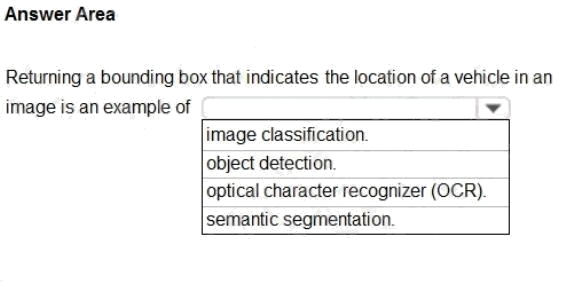
Answer:
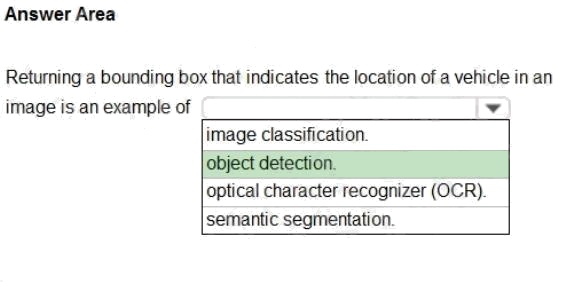
Explanation:
Reference: https://docs.microsoft.com/en-us/azure/cognitive-services/computer-vision/concept-object-detection